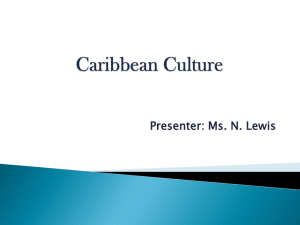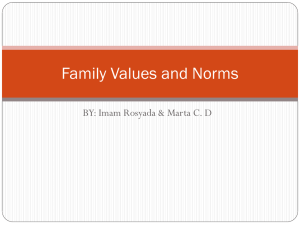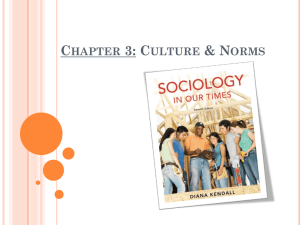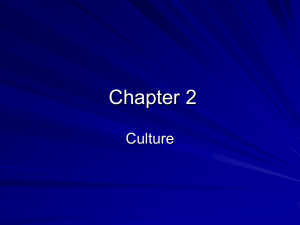What Is Culture?
advertisement
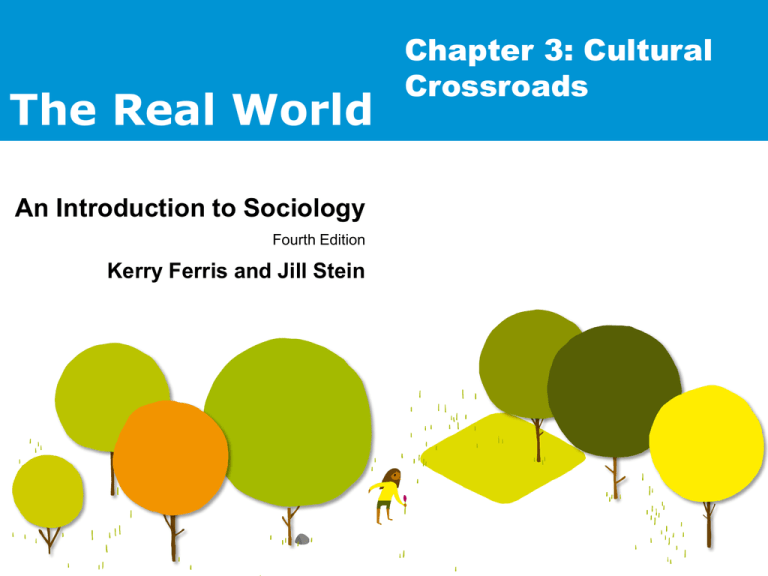
The Real World An Introduction to Sociology Fourth Edition Kerry Ferris and Jill Stein Chapter 3: Cultural Crossroads What Is Culture? • Culture is the entire way of life for a group of people. • It is hard for us to see our own culture, so we may not recognize the extent to which it shapes and defines who we are. 2 What Is Culture? (cont’d.) • Culture includes things such as language, standards of beauty, hand gestures, styles of dress, food, and music. • Culture is learned. It is passed from one generation to the next through communication—not genetics. 3 Ethnocentrism • Ethnocentrism occurs when people use their own culture as a standard to evaluate another group or individual, leading to the view, that cultures other than their own are abnormal. 4 5 Cultural Relativism • Cultural relativism is the process of understanding other cultures on their own terms, rather than judging according to one’s own culture. • When studying any group, it is important to try to employ cultural relativism because it helps sociologists see others more objectively. 6 Components of Culture • Culture consists of two different categories: material culture and symbolic culture. 7 Components of Culture: Material Culture • Material culture includes the objects associated with a cultural group, such as tools, machines, utensils, buildings, and artwork. 8 Components of Culture: Symbolic Culture • Symbolic culture includes ways of thinking (beliefs, values, and assumptions) and ways of behaving (norms, interactions, and communication). • One of the most important functions of symbolic culture is to allow us to communicate through signs, gestures, and language. 9 Components of Culture (cont’d.) • Signs (or symbols), such as a traffic signal or product logo, are used to meaningfully represent something else. • Gestures are the signs that we make with our body, such as hand gestures and facial expressions; it is important to note that these gestures also carry meaning. 10 11 Components of Culture (cont’d.) • Finally, language is a system of communication using vocal sounds, gestures, and written symbols. • This is probably the most significant component of culture because it allows us to communicate. 12 Components of Culture (cont’d.) • Language is so important that many have argued that it shapes not only our communication but our perceptions and how we see things as well. • The Sapir-Whorf hypothesis, which is the idea that language structures thought and that ways of looking at the world are embedded in language, is based on this premise. 13 Culture Includes Values and Norms • Values are shared beliefs about what a group considers worthwhile or desirable; they guide the creation of norms. • Norms are the formal and informal rules regarding what kinds of behavior are acceptable and appropriate within a culture. 14 Norms • Norms are specific to a culture, time period, and situation. • Norms can be either formal, such as a law or the rules for playing soccer, or informal—not written down and unspoken. 15 Types of Norms • Types of norms can also be distinguished by the strictness with which they are enforced. 16 Types of Norms: Folkways • A folkway is a loosely enforced norm that involves common customs, practices, or procedures that ensure smooth social interaction and acceptance. 17 Types of Norms: Mores • A more is a norm that carries greater moral significance, is closely related to the core values of a group, and often involves severe repercussions for violators. 18 Types of Norms: Taboos • A taboo is a norm engrained so deeply that even thinking about violating it evokes strong feelings of disgust, horror, or revulsion for most people. 19 How Do We Enforce Norms? • Sanctions are positive or negative reactions to the ways that people follow or disobey norms, including rewards for conformity and punishments for norm violators. Sanctions help to establish social control, the formal and informal mechanisms used to increase conformity to values and norms and thus increase social cohesion. 20 Variations in Culture • Multiculturalism values diverse racial, ethnic, national, and linguistic backgrounds and thus encourages the retention of cultural differences within society, rather than assimilation. 21 Dominant Culture • The dominant culture refers to the values, norms, and practices of the group within society that is most powerful in terms of wealth, prestige, status, and influence. 22 Subcultures • A subculture is a group within society that is differentiated by its distinctive values, norms, and lifestyle. 23 Countercultures • A counterculture is a group within society that openly rejects, and may actively oppose, society’s values and norms. 24 Cultural Change • Cultures usually change slowly and incrementally, though change can also happen in rapid and dramatic ways. • At times, a subculture can influence the mainstream and become part of dominant culture, or something that is dominant can change to a counterculture. 25 Chapter 3: Participation Questions Many different cultures are present in America. Do you think America is a “melting pot” or a “tossed salad?” a. “melting pot” (cultural leveling) b. “tossed salad” (cultural diffusion) 26 Chapter 3: Participation Questions Technology’s impact on American culture has been mainly a. positive. b. negative. 27 Chapter 3: Participation Questions In your opinion, which of the following gestures has the strongest meaning in American culture? a. b. c. c. 28 Chapter 3: Participation Questions Which of the following gestures has the strongest meaning in a “trekkie” (Star Trek fans) subculture? a. b. c. 29 This concludes the Lecture PowerPoint presentation for Chapter 3 © 2014 W. W. Norton Co., Inc. The Real World AN INTRODUCTION TO SOCIOLOGY 4th Edition Kerry Ferris and Jill Stein 30



